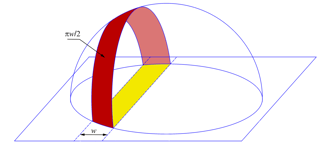Let $K\subset R^2$ be a convex body, i.e., a compact convex set with interior points. A plank $P$ is the region between a pair of parallel lines in $R^2$. Let us say that $P$ intersects $K$ properly provided that both boundary lines of $P$ intersect $K$.
Question: Let $K\subset R^2$ be a convex body with diameter $d$. Suppose there exists a measure $\mu$ on $K$ such that $\mu(P\cap K)$ is constant for all planks of some fixed width $0<h<d$ which properly intersect $K$. Must $K$ then be a disk?
A disk $D\subset R^2$ does indeed admit such a measure. Let $S\subset R^3$ be a sphere with $D$ as an equatorial disk, and $\mu$ be the measure on $D$ induced by the projection of $S$ (see the picture below which is from this paper of Kupavskii and Pach). Then $\mu$ will be plank invariant due to the Archimedes hatbox theorem.
The motivation for the above question is that a positive answer here would yield a positive answer to this earlier question, on the Converse of the Archimedean property of the sphere, as follows.
Suppose that there exits a convex surface $S\subset R^3$ with the Archimedean slab invariant area property mentioned in the earlier question. Then the projection of $S$ into any plane would yield a convex body with the plank invariant property with respect to the induced measure. Hence the projection would be a disk, if the answer to the above question were yes, which would in turn imply that $S$ is a sphere (it is well-known that the sphere is the only convex surface with round projections).
For some results in the direction of the above problem see this paper of Gardner. Another nice paper discussing some relevant background and questions is the expository paper of King in the Monthly. More references can be found in the recent paper of Kupavskii and Pach mentioned above. Also see the answer to this related question asked earlier, and another similar question which has remained unanswered. Questions of this type have connections to Tarski's plank problem and an open question of Bang.

